Abstract
Analysis of the relationships among ecosystem services (ESs) can help ensure that benefits from ecosystems are consistent over time. This study explored the spatial and temporal patterns of water supply (WS), grain supply (GS), carbon storage (CS), water conservation (WC), soil conservation (SC), and habitat quality (HQ) in the Wujiang River Basin (WJRB) from 2000 to 2020 and the trade-off/synergy relationships of ESs. The ESs in the WJRB are downstream > midstream > upstream in space, with the greatest increase and decrease in the upstream and midstream temporal dimensions, respectively. The WS, WC, and SC underwent a trend shift in 2005 due to climatic influences, whereas GS and HQ underwent a trend shift in 2010 due to human social development. GS formed a trade-off with other ESs in the spatial pattern, whereas WS formed a trade-off with CS and WC in the temporal dimension. Adjusting the GS spatial pattern reduces the trade-off between ESs in the spatial pattern, allowing for focusing on monitoring soil and water erosion-prone areas to prevent extensive soil erosion during heavy precipitation years; this reduces the trade-off between ESs in the time dimension in the WJRB. This provides a theoretical basis for achieving high-quality WJRB development.
1. Introduction
Ecosystem services (ESs) refer to the various benefits derived from natural ecological processes. Analyzing the spatial and temporal patterns of ESs can help quantify the extent to which natural ecosystems benefit human society to allow decision-makers and managers to manage and allocate environmental resources more effectively [1]. In ecosystems, ESs interact with each other in complex and dynamic ways, with varying degrees of trade-off and synergy [2]. Trade-offs are situations wherein one service increases and another decreases, and synergies are situations wherein two services simultaneously increase or decrease [3]. Research on trade-offs/synergies in ESs is becoming an important basis for ecological management decisions and regulation since it can clarify the relationships among ESs to ensure the long-term stable provision of ESs [4].
ES trade-offs/synergies are mainly analyzed in space and time using methods, such as correlation coefficients [5], ecosystem services bundles [6], analysis of variance [7], and Bayesian networks [8]. The correlation coefficient method is often used in large-scale studies to obtain more intuitive analytical results owing to the spatial heterogeneity of ESs and the complexity of trade-offs and synergistic relationships. For example, Spearman’s coefficients were used to analyze the trade-off/synergy effects of ESs in the Ulansu Sea Basin and the Qinghai–Tibet Plateau [9,10], while Pearson’s coefficients were used to analyze the trade-off/synergy effects of ESs in the Han River Basin and Guizhou Province [11,12]. These studies used the correlation coefficient method to derive the overall trade-off/synergistic relationship among ESs and obtained relatively intuitive analytical results; however, owing to the spatial heterogeneity of ESs and the complexity of the trade-off/synergistic relationship, it is difficult to reflect the spatial relationship of the ES trade-off/synergistic relationship in a purely mathematical relationship [6], and the implementation location of the guiding recommendations based on this is not specific, which makes it difficult to implement the recommendations. Ecosystem service bundles (ESBs) provide a viable solution to this problem. ESBs refer to a series of spatially recurring combinations of multiple types of ESs, which characterize the complex interactions of multiple ESs in space [2]; the high and low levels of different ESs in the bundles reflect trade-offs/synergistic relationships [13]. At present, the identification methods of ESBs are relatively mature, and most adopt the clustering method to analyze multiple ESs; the obtained “classes” are the ESB in the study area. Shen, Guo et al. applied K-cluster analysis to depict ESB in space in the Beijing–Tianjin–Hebei urban agglomeration and Three Gorges Reservoir Area [14,15], analyzed the spatial heterogeneity of ES trade-off/synergistic relationships, and proposed a manageable scheme for natural capital and ES. Therefore, after the correlation coefficient method was used to derive the overall trade-offs/synergies among ESs, applying ESBs to analyze the spatial pattern of ES trade-offs/synergies can more accurately clarify the trade-offs/synergies of ESs. Moreover, current measurements focus on trade-offs and synergies in spatial patterns, with less consideration given to the temporal dimension. The spatial trade-offs of individual periods are generally the main focus, even in the case of a long time series of trade-offs/synergies analysis of ESs, and the temporal dimension is rarely integrated and quantified. This is not conducive to accurately grasping the trade-offs/synergies of ESs in time and space and affects the feasibility and accuracy of guiding production management recommendations. To address this issue, quantifying changes in ESs in the time dimension to quantitatively explore the trade-offs/synergies of ESs in the spatiotemporal time dimension can lead to more reliable natural capital management strategies.
Wujiang River is an important part of the basin since it is the largest tributary on the south bank of the upper Yangtze River. It provides important ecological support for the entire upper Yangtze River and serves as an important ecological barrier [16]. The WJRB has experienced rapid economic development in the past 20 years. The implementation of several ecological projects combining intensive human and social activities with significant ecological restoration [17] makes WJRB a microcosm representative of the development of the southwest region of China. The stable development of ESs in the WJRB is an important prerequisite for the synergistic development of the region; however, climate change and human activities have increased the uncertainty of ES changes in the region. Current studies on ESs in the WJRB are only available for individual periods in fragments of the basin, and studies on complete basins over long timescales are lacking.
This study aimed to systematically analyze the spatiotemporal patterns and trade-off/synergistic relationships of ESs in the WJRB. We accounted for water supply (WS), grain supply (GS), carbon storage (CS), water conservation (WC), soil conservation (SC), and habitat quality (HQ) in the WJRB from 2000 to 2020. The results were compared with empirical data to verify the accuracy of the accounting results. Systematic analysis of the trade-off/synergistic relationships of ESs in space and time and the partial dependency diagram model (PDP model) were used to map the response relationships of trade-off ESs and explore ways to attenuate trade-offs in the context of realizing the benefits of ESs. These results can provide a theoretical basis and reference for management enhancement and sustainable use of ESs in the region.
2. Materials and Methods
2.1. Study Area
The WJRB is in the central part of southwest China between the transition zone of the second and third steps in China. It is a typical karst area, between 26°07′N–30°22′N and 104°18′E–109°22′E, with an area of 8.8 × 104 km2. The basin is approximately 600 km long from east to west and 500 km from north to south (Figure 1). The highland mountains and hills account for approximately 85% of the total area of the basin, hills account for approximately 10%, and the basin, river terraces, and karst plains account for the remaining 5%. The elevation gradually decreases from west to east, with an average elevation of 1100 m. The WJRB has a subtropical monsoon climate, with an average annual temperature of 13–18 °C, temperature variation is greater in winter than in summer, with average annual rainfall ranging from 900 to 1400 mm. The spatial distribution of rainfall is uneven, with the downstream (Wujiang River below Sinan) greater than the upstream (Wujiang River above Huawuji), and the right bank greater than the left bank [16].
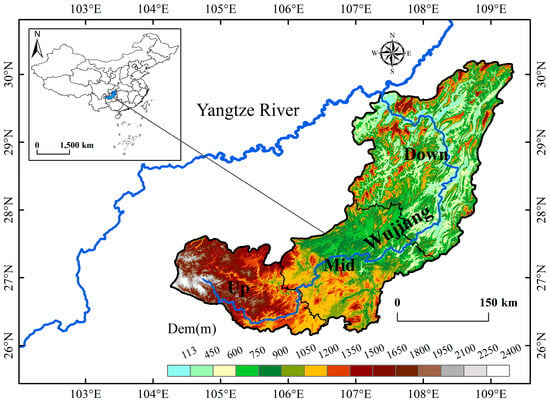
Figure 1.
Location of the study area. The map of China was produced in accordance with the standard map service of the Ministry of Natural Resources, review number GS(2020)4634, unaltered base map.
2.2. Data Sources
The boundaries were derived from the National Bureau of Mapping and Geographic Information (https://zwfw.ch.mnr.gov.cn/index, accessed on 1 March 2023). Sources of land-use data, soil data, meteorological data, etc., used to account for ecosystem services are detailed in Table 1.

Table 1.
Data sources.
2.3. Methods
2.3.1. ES Assessment
The WJRB is complex and provides multiple ESs. This study selected three of six ESs based on the four categories of ESs included in the UN Millennium Assessment to provide a more comprehensive assessment of the ESs in the study area. Data availability, temporal continuity, and the ecological function positioning for the WJRB—provisioning services (water supply (WS) and grain supply (GS)), regulating services (carbon storage (CS) and water conservation (WC)), and supporting services (soil conservation (SC) and habitat quality (HQ))—were taken into account. The detailed methodology for each ES assessment is as follows:
- 1.
- Water supply
InVEST (Integrated Valuation of Ecosystem Services and Tradeoffs), developed by Stanford University (https://naturalcapitalproject.stanford.edu/software/invest, accessed on 1 March 2023), is one of the most comprehensive open-source softwares for ecosystem service quality accounting. Numerous studies have proved the accuracy of its assessment results, and it is one of the most widely used software models for ecosystem service quality assessment research [9,10,11,12]. The WS was calculated in the water yield module of the InVEST model, which provides an accounting method based on the water balance. Water production is the amount of precipitation in a grid cell minus the amount of water evaporated, and the more water produced per unit area, the greater the WS [18]. The specific algorithm is shown in Equation (1).
where Y(i) is the water supply (mm), AET(i) is the annual actual evapotranspiration (mm), and P(i) is the annual precipitation (mm) of grid i.
- 2.
- Grain supply
Grain yield reflects the net productivity of food crops and has a significant linear relationship with the net primary productivity (NPP) of plants [19]. We employed statistical analyses to gather grain yield data for cities and counties within the WJRB. We further established a relationship between these data and the NPP of cultivated land in the respective areas. Subsequently, we spatially quantified the annual grain yield in the WJRB [20].
where is the food production of grid i (kg), is the sum of the food production in the study area (kg), is the net vegetation productivity of grid i, and is the sum of the net vegetation productivity in the study area. NPP data sources are given in Table 1.
- 3.
- Carbon storage
The carbon stocks of large regions are often calculated by combining the carbon module of the InVEST model with a spatial correction method [15,21]. This study calculated carbon stocks in four components, namely, aboveground biomass, belowground biomass, soil, and apocrypha, based on the InVEST model to account for carbon stocks in each period and correct for terrestrial net ecosystem productivity (NEP) in each year [16].
where is the carbon stock of grid i (Mg); , , and are the carbon densities of aboveground biomass, belowground biomass, soil, and apoplankton of grid i (Mg/hm2), respectively (sources given in Table 1); is the total carbon sequestration service of the ecosystem (Mg); is the area of grid i (hm2); is the spatial correction factor of NEP; and NEP is converted to with a mean value of 1 and a range of [0, 2] using the subordinate fuzzy method.
- 4.
- Water conservation
Ecosystem water conservation is the ability of ecosystems to retain, infiltrate, and store precipitation through their unique structure and water interactions and to regulate water flows and the water cycle through evapotranspiration [22]. The topographic index, soil saturation hydraulic conductivity, and flow rate coefficient were integrated to obtain WC based on the obtained WS:
where Retention is the water conservation (mm), Velocity is the flow rate coefficient, TI is the topographic index, Ksat is the soil saturation hydraulic conductivity (cm/d), and Y(i) is the water supply of grid i (mm).
The velocity referred to related studies [22]. TI was calculated based on soil depth and slope, and soil saturated hydraulic conductivity was calculated from soil texture.
where TI is the topographic index, is the number of rasters in the catchment, is the soil depth (mm), is the percent slope, Ksat is the saturated hydraulic conductivity of the soil, sand is the sandy content of the soil (%), clay is the clay content of the soil (%), OM is the organic matter content of the soil (%), and ρ is the bulk weight. Data sources are provided in Table 1.
- 5.
- Soil conservation
This was calculated in the sedimentation module of the InVEST model, which uses the soil circulation equation to calculate the actual and potential soil erosion for each image element, and the two are subtracted to obtain the SC [18]. The specific algorithm is shown in Equations (8)–(10):
where USLE is actual soil erosion (t), RKLS is potential soil erosion (t), SC is soil conservation (t), R is the rainfall erosion factor, K is the soil erodibility factor, LS is the slope length factor, C is the vegetation and management factor, and P is the support for conservation measures.
The rainfall erosion factor R was calculated based on monthly mean precipitation (Equation (11)); the soil erodibility factor K was calculated based on soil composition (Equations (12) and (13)); the vegetation and management factor C was calculated based on the Normalized Vegetation Index (NDVI; Equations (14) and (15)); and the factor for support of conservation measures, P, was determined in the context of the relevant literature [14].
where R is the annual rainfall erosivity, p is the average annual rainfall (mm), pn is the average rainfall in the nth month, K is the soil erodibility factor, sand is the soil sand grain content (%), silt is the soil powder particle content (%), clay is soil clay particle content (%), OM is soil organic matter content (%), is the vegetation cover of raster i, is the value of NDVI, is the value corresponding to the cumulative probability of 0.05% for NDVI in the study area, is the value corresponding to the cumulative probability of 99.5% for NDVI in the study area, and C is the vegetation and management factor. Data sources are given in Table 1.
- 6.
- Habitat quality
The HQ module in the InVEST model was used for assessing HQ, and the degree of habitat degradation was obtained by establishing the link between habitat data and threat factors, calculating the negative impact of threat factors on the habitat after considering factors, such as the distance and intensity of the influence of threat factors, and calculating HQ based on the degree of degradation and habitat suitability.
where is the habitat quality index of raster i in the land use type, is the habitat suitability of the land use type, is the habitat degradation of raster i in the land use type, and K is a half-saturation constant (value of 0.5). and were determined by referring to relevant studies [23,24].
2.3.2. Trends in ESs in the Time Dimension
Temporal information entropy is an effective method to analyze the characteristics of temporal changes; it can fully explore the information regarding changes in ecological environment elements in the time dimension and characterize the data on change intensity and trend of environmental elements in a certain period [25]. Conventional image-by-image trend analysis can also analyze temporal changes; however, it cannot effectively deal with outliers and is prone to deviations in change intensity and trend owing to individual outliers. Moreover, the problem of insignificant p-values requires a resolution. Therefore, this study used information entropy to analyze the change in each element in the time dimension based on the improved algorithm of Wang and Zhao [26]:
where H is the temporal information entropy value, m is the temporal frequency factor, n is the number of environmental elements, j is the number of time intervals, and Δ is the scaling factor (this value generally takes the base change unit as 0.02 times of the value range of the corresponding index). A positive H value indicates an increasing trend in the environmental elements in this period and vice versa (a decreasing trend). The larger the value of H, the greater the intensity of change in environmental elements during the period; the lower the H value, the smaller the intensity of change.
2.3.3. Trade-Offs and Synergy Analysis of ESs
There is a synergistic relationship when the correlation coefficient is >0 based on the magnitude of the correlation (Spearman’s coefficient). The larger the value, the higher the degree of synergy. There is a trade-off relationship when the correlation coefficient is <0; the smaller the value, the higher the degree of trade-off [9,10].
2.3.4. ESB Analysis
ESBs were analyzed using the K-means clustering algorithm, an unsupervised clustering method that, after determining the number of clusters k and the input dataset, obtains k sets of objects in the same cluster that have the highest degree of similarity and the lowest degree of similarity with the objects in different categories [27]. k was determined based on the fviz_nbclust function of the package “factoextra” in R. The amount of material of each ES in the spatial pattern should be standardized and converted to dimensionless data before data analysis [15], and the entropy value of temporal information was used in the temporal dimension. Finally, the calculation of the composition of ecosystem service clusters was realized based on the GeoDa 1.20 software (https://geodacenter.github.io/, accessed on 1 March 2023), and ESBs were mapped to reveal their spatial distribution.
2.3.5. Nonlinear Relationship of ESs
The PDP model is a global explanatory model that analyzes the marginal effects among factors and demonstrates complex linear or nonlinear responses among variables [28]. The PDP model was applied to analyze the marginal effects of trade-offs among ESs and propose management recommendations to attenuate trade-offs based on the nonlinear relationships among trade-off ESs.
3. Results
3.1. ES Assessment Results
The spatial distribution of WS, CS, WC, and HQ in the WJRB in the same period showed a pattern of downstream > midstream > upstream, with a high northeast and low southwest distribution. Meanwhile, the spatial distribution of GS showed a pattern of upstream > midstream > downstream, with a high southwest and low northeast distribution every year. The spatial distribution of SC showed a pattern of upstream > downstream > midstream, with the lowest SC service in the central part (Figure 2, Figure 3, Figure 4, Figure 5, Figure 6 and Figure 7).
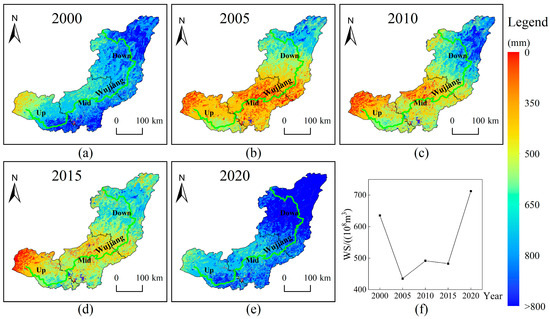
Figure 2.
Spatial distribution of water supply (WS) from 2000 to 2020 in the Wujiang River Basin. (a) WS in 2000, (b) 2005, (c) 2010, (d) 2015, and (e) 2020. (f) Change in WS between 2000 and 2020.
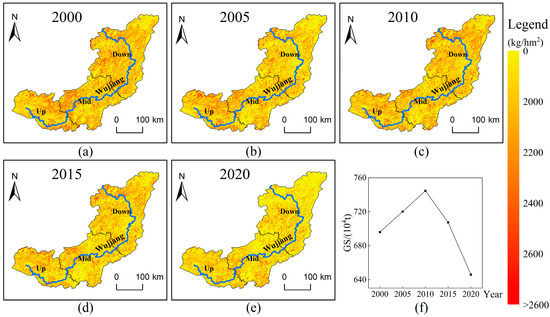
Figure 3.
Spatial distribution of grain supply (GS) from 2000 to 2020 in the Wujiang River Basin. (a) GS in 2000, (b) 2005, (c) 2010, (d) 2015, and (e) 2020. (f) Change in GS between 2000 and 2020.
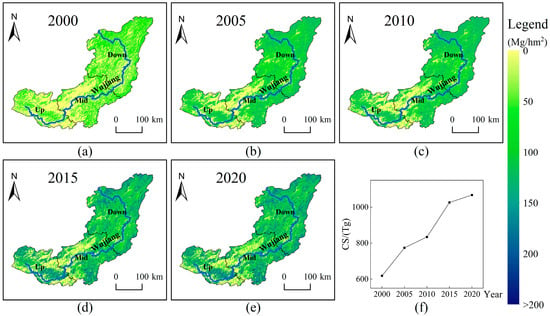
Figure 4.
Spatial distribution of carbon storage (CS) from 2000 to 2020 in the Wujiang River Basin. CS in (a) 2000, (b) 2005, (c) 2010, (d) 2015, and (e) 2020. (f) Change in CS between 2000 and 2020.
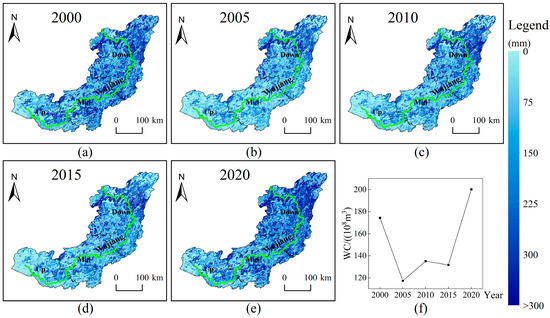
Figure 5.
Spatial distribution of water conservation (WC) from 2000 to 2020 in the Wujiang River Basin. WC in (a) 2000, (b) 2005, (c) 2010, (d) 2015, and (e) 2020. (f) Change in WC between 2000 and 2020.
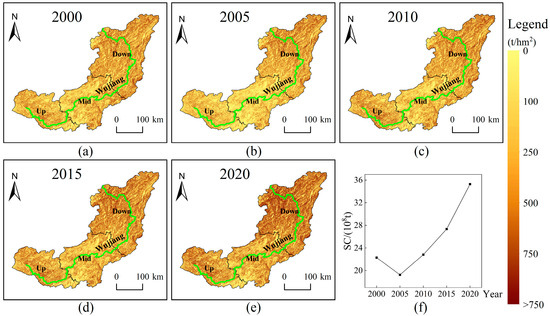
Figure 6.
Spatial distribution of soil conservation (SC) from 2000 to 2020 in the Wujiang River Basin. SC in (a) 2000, (b) 2005, (c) 2010, (d) 2015, and (e) 2020. (f) Change in SC between 2000 and 2020.
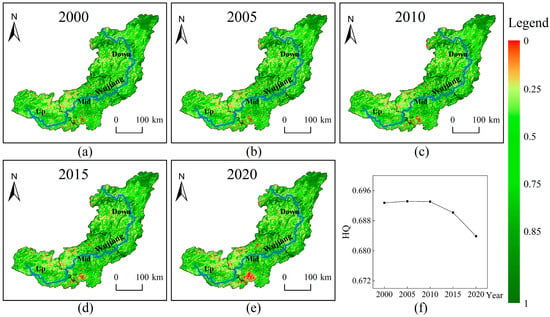
Figure 7.
Spatial distribution of habitat quality (HQ) from 2000 to 2020 in the Wujiang River Basin. HQ in (a) 2000, (b) 2005, (c) 2010, (d) 2015, and (e) 2020. (f) Change in HQ between 2000 and 2020.
CS continually increased during the study period (Figure 4f), whereas other ESs changed their trends in 2005 and 2010. The time point of change for WS, WC, and SC was 2005, with decreases between 2000 and 2005 and increases between 2005 and 2020 (Figure 2f, Figure 5f and Figure 6f). The changes in GS and HQ occurred in 2010, with decreases between 2000 and 2010 and increases between 2010 and 2020 (Figure 3f and Figure 7f).
3.2. Spatiotemporal Trends in ESs
Analysis of spatial and temporal trends in ESs in the WJRB during 2000–2020 was based on temporal information entropy. The temporal information entropy of water supply (HWS) showed that between 2000 and 2020, the increase in WS in the WJRB gradually decreased from the central part outward, with the high increase areas located in the midstream region and a band of increasing areas in the middle of the downstream region. More areas of decline were mainly clustered in the western part of the upstream region and the northern part of the downstream region (Figure 8a). Temporal information entropy of grain supply (HGS) showed that GS had an increasing trend in the upstream region and the southern part of the downstream region between 2000 and 2020, while the middle and northern parts of the downstream region showed a decreasing trend (Figure 8b). Temporal information entropy of carbon storage (HCS) showed that the western part of the upstream region and the central part of the downstream region had the greatest increases in CS between 2000 and 2020, while the middle reaches exhibited more decreases (Figure 8c). Temporal information entropy of water conservation (HWC) showed that the western part of the upstream region had the highest increase in WC between 2000 and 2020; meanwhile, the eastern part of the downstream region had a band of increasing regions, while the eastern part of the upstream and the midstream regions shows a decreasing trend and a tendency to extend toward the western part of the upstream region (Figure 8d). The temporal information entropy of soil conservation (HSC) showed that the areas with increased SC were located in the western part of the downstream region between 2000 and 2020, and the areas with more decreasing SC were located in the eastern part of the downstream region (Figure 8e). The temporal information entropy of habitat quality (HHQ) showed the most apparent decline in urban areas, with significant declines in Guiyang, Bijie, and Zunyi in Guizhou Province. The Moran’s I of HHQ was 0.222 (p < 0.05), indicating that the spatial and temporal trends of HQ have significant spatial aggregation.
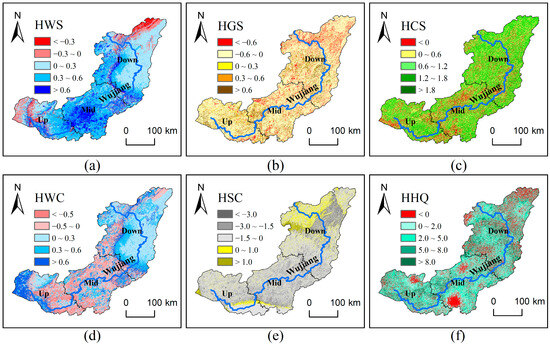
Figure 8.
Spatiotemporal trends in ESs. (a) Spatiotemporal trends in WS, (b) GS, (c) CS, (d) WC, (e) SC, and (f) HQ.
3.3. Trade-Offs and Synergy Analysis of ESs
The spatial pattern showing the trade-off/synergistic relationships among ESs in the five periods between 2000 and 2020 remained relatively stable. WS was weakly synergistic with GS for provisioning services, CS was synergistic with WC for regulating services, and SC was synergistic with HQ for supporting services. GS had a trade-off with all regulating and supporting services, with HQ (a support service) having the highest degree of trade-off and an average correlation coefficient of −0.84. There were synergistic relationships between regulating and supporting services; however, the synergy between regulating and supporting services was stronger. For example, the average correlation coefficient between CS and WC was 0.40, while the average correlation coefficients between CS and SC and between CS and HQ were 0.57 and 0.65, respectively(Figure 9).
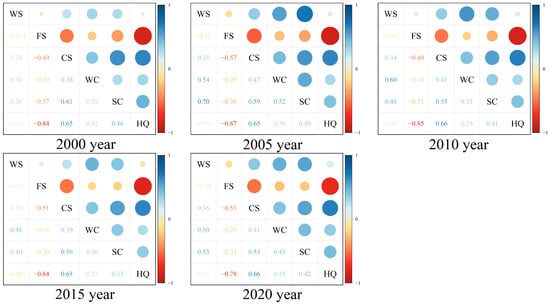
Figure 9.
Correlation coefficients of ESs in the spatial patterns.
The trade-off/synergistic relationship of each ES in the temporal dimension was weak, with only WS showing a trade-off relationship with CS and WC, with correlation coefficients of −0.25 and −0.31, respectively. CS showed positive correlations with other ESs; however, the correlation coefficients were <0.2, indicating weak synergies. This suggested that only WS had a strong negative correlation with variation trends in CS and WC on a 20-year timescale, whereas all other ESs had a low correlation over time(Figure 10).
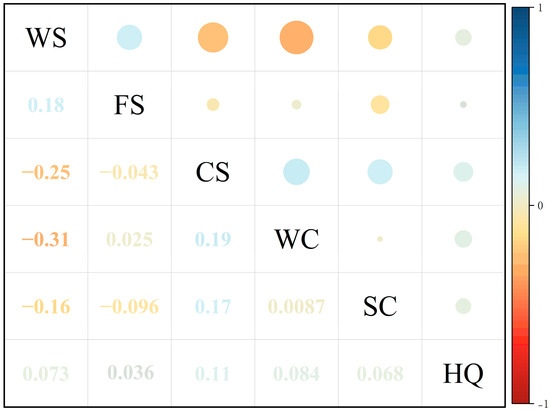
Figure 10.
Correlation coefficients of ESs in the time dimension.
3.4. Compositional Structure and Spatial Pattern of ESBs
The trade-off synergistic relationship of each ES was stable in different years; therefore, the mean values of ESs in five periods were taken to analyze the clusters of ESs in the spatial pattern. fviz_nbclust function calculations showed that the total sum of squares in the clusters tended to be stable when the number of clusters was 4; the number of clusters was therefore determined to be 4.
In the spatial pattern, ESB I, with a better ecological environment than others, accounted for 16.06% of the area of the WJRB; this bundle was located at higher elevations, with low anthropogenic interference and high vegetation cover (>75%) [16]. The supply capacities of the remaining five services in the bundle were high, except for the low capacity of the GS; HQ, SC, and CS were the highest among the four types of bundle, which showed a trade-off relationship between GS and the rest of ESs. ESB II accounted for 16.93% of the WJRB and had a more prominent WC (more than twice that of the other bundles). Most ESB II areas were on the periphery of ESB I, resulting in a high ES provisioning capacity. The GS was slightly higher than that of ESB I and far higher than that of the other bundles. ESB III accounted for 31.00% of the area of the WJRB; with a high level of agricultural production and a very high level of GS, this bundle was concentrated in the low-elevation plains of the WJRB. The main land use type in this region is arable, and 90% of the food in the WJRB is produced in this area. The level of WS in this bundle was also high, illustrating the synergistic relationship between GS and WS, while the supply level of other ESs was low; WC, SC, and HQ were the lowest values for the four types of ESB, which also demonstrates the trade-off relationship between GS and each ES (except for WS). ESB IV accounted for 36.00% of the area of the WJRB, which is an ecologically fragile area with a low level of supply of all ESs. This bundle accounted for the largest share of the WJRB and was concentrated in the center of the urban areas in all districts and counties of the WJRB (Figure 11).
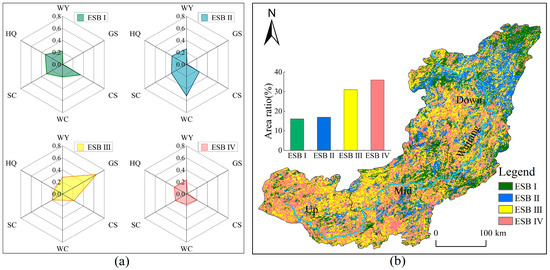
Figure 11.
Composition and distribution patterns of ecosystem service bundles (ESBs): (a) compositions of four types of ESBs and (b) spatial patterns of four types of ESBs.
In the time dimension, HESB I accounted for 20.57% of the area of the WJRB; as an ecological environment enhancement area, it was concentrated in nature reserves and national karst rocky desertification prevention and control zones, where more ecological protection measures have been implemented [16]. The value of the bundle’s HHQ was the highest of the four types of bundles. HESB II accounted for 35.54% of the area of the WJRB. As an area of CS growth, HCS had the highest value among the four types of bundles. Moreover, it was the bundle with the largest percentage of the area within the WJRB, concentrated at middle elevations and dominated by woodland and shrubs. At the same time, the growth of WC within the bundle was also the highest, and the value of HWC was the highest among the four types of bundles. This demonstrates the synergistic relationship between WC and CS in the temporal dimension. HESB III accounted for 18.16% of the area of the WJRB; as an area of agricultural development, it was mainly located in the upper and middle reaches of the cultivated land. The HGS was the highest among the four types of bundles, and HWC was the lowest, indicating a trade-off between GS and WC in the time dimension. HESB IV, which accounted for 25.73% of the area of the WJRB, had the highest WS growth owing to the high slope; water erosion brought about by this increase affected the benign growth of the remaining ESs. HHQ, HSC, and HCS had the lowest values among the four bundles, and HWC had the lowest value except for HESB III, indicating a trade-off between WS and HQ, SC, CS, and WC in the time dimension (Figure 12).
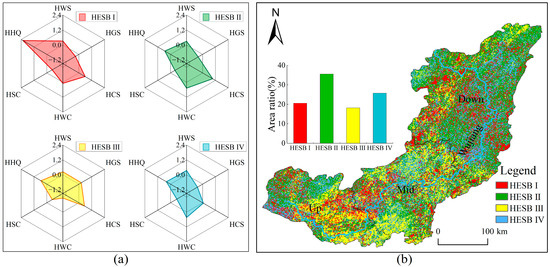
Figure 12.
Composition and distribution patterns of ecosystem service bundles (ESBs) in the time dimension: (a) composition of the four types of ESBs and (b) spatial patterns of four types of ESBs.
3.5. Nonlinear Relationship of ESs
In the spatial pattern, the correlation coefficients between GS and CS, WC, SC, and HQ were all <−0.2; the compositional structures of ESB I and ESB III also suggest that higher levels of provisioning of GS are associated with lower levels of provisioning of CS, WC, SC, and HQ, and vice versa, suggesting a strong trade-off between GS and each of these ESs. The response curves showed that the interrelationships between GS and CS and between GS and HQ were relatively simple, showing a univariate negative correlation function. Meanwhile, the relationship between GS and WC followed a quadratic function (first promoting, then inhibiting), while that between GS and SC also followed a quadratic function (first inhibited, then promoted). The response curves at the catchment scale showed that the trade-off effect of GS with other ESs was low when the GS was approximately 700 kg/hm2. The GS in the WJRB in 2020 was 735.08 kg/hm2; adjusting the spatial pattern of GS within the areas of ESB I and ESB III effectively reduced the trade-off effects between ESs in the spatial pattern(Figure 13).
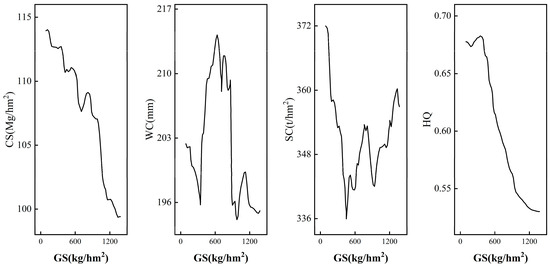
Figure 13.
Nonlinear relationships of ES trade-offs in the spatial patterns.
The correlation coefficients of HWS with HCS and HWC were all >0.2. In the composition structure of HESB IV, the value of HWS was higher, and the values of HCS and HWC were lower, indicating a strong trade-off relationship in the time dimension, mainly between WS and CS and WC. The WJRB is a typical karst landscape with a subtropical monsoon climate; precipitation is abundant, and in HESB IV (e.g., high slope areas), increased precipitation can wash away the surface and remove the already thin soil layer, while soil formation is slower in karst than in normal areas [29]. In the long run, increased precipitation can cause local erosion and lower the CS and WC. Water supply is highly correlated with precipitation: WS increases as precipitation increases [30]. The trade-off between WS, CS, and WC in the time dimension is an erosion problem caused by increased precipitation(Figure 14).
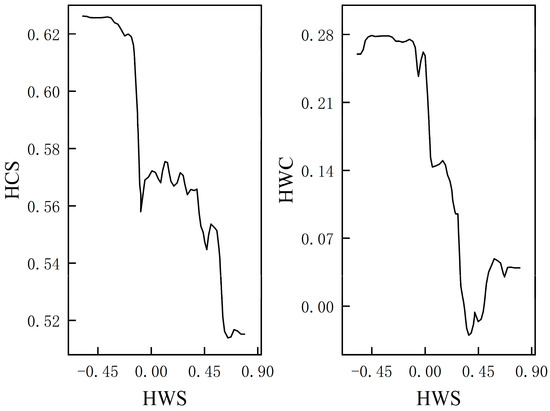
Figure 14.
Nonlinear relationships of synergy between ESs in the time dimension. HCS, the entropy of carbon storage; HWS, the entropy of water supply.
4. Discussion
4.1. ES Spatial–Temporal Characteristics
Accurate accounting of ESs is a prerequisite for analyzing their spatial and temporal patterns [31]. There are various ways to account for ESs, and large-scale accounting is often achieved by models. However, large-scale studies only rely on highly uncertain remote sensing models and are prone to a high magnitude of differences. For example, the carbon sinks in China varied between 0.1 and 1.1 Pg owing to different accounting methods [32]. In this study, the accounting of ESs was mainly achieved using the InVEST software, which is commonly used for ES accounting, and several studies proved its reliability [8,9,10,11]. The results of this study were compared with data from government gazettes, statistical yearbooks, and surveys to verify the relative accuracy of the results and ensure their usability for subsequent analysis. It should be noted that data such as government bulletins, statistical yearbooks, and survey data may have a certain degree of error, which can lead to discrepancies between modeled values and actual ecosystem services. In addition, there is no more effective validation program owing to the involvement of long time-scale data; therefore, research methods based on the comparison of model results with published data can be a viable research paradigm.
The error of the WS for each year in this study was within 0.5% of the values in the Water Resources Bulletin of the Yangtze River Basin and Southwestern Rivers, published by the Ministry of Water Resources, which is generally accurate (Figure 15a). The fit between the GS and the grain production data of the statistical yearbooks of cities and counties was >0.85 (Figure 15c). CS and WC were in good agreement with results based on field sampling [33,34]. The actual loss in SC was similar (±5%) to the sediment volume in the China Rivers Sediment Bulletin (Figure 15b). The spatial pattern of HQ was similar to that of the ecological condition index of each county in the Guizhou Province State Environment Bulletin. Therefore, the model results of this study are reliable and can be used for further analyses.
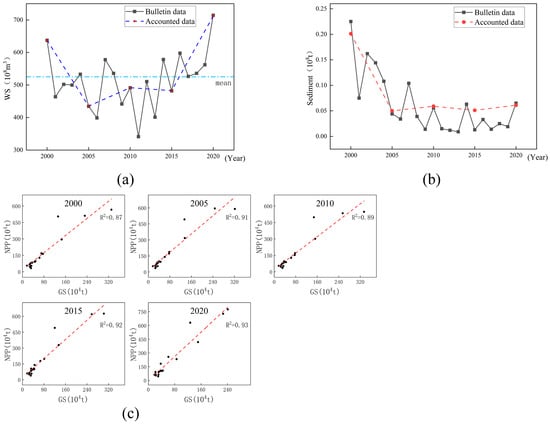
Figure 15.
Verification of accounting for ecosystem services (ESs): (a) verification of water supply (WS), The blue dotted line shows the average value of government data (b) soil loss, and (c) grain supply (GS). NPP, net primary productivity.
The spatial characteristics of ESs in the WJRB were generally downstream > midstream > upstream. This contrasts with previous studies on ESs in the basin: ESs were generally upstream, midstream, and downstream. The situation in the WJRB is caused by the unique natural geomorphology and human activity. The upper reaches of the Wujiang River are characterized by karst landscapes, large elevation differences, and low vegetation cover (vegetation cover of ~50% [16]), which make them prone to soil erosion. The Chinese government identifies them as the “Karst Rock Desertification Prevention Ecological Function Area” [35]. Simultaneously, the population density of the WJRB is much greater upstream and midstream than it is downstream, and human activities have a greater impact on the upstream and midstream [36].
The trend shifts in WS, WC, and SC in 2005 were mainly owing to the influence of the natural climate. Precipitation in the WJRB decreased from 2000 to 2005 and increased from 2005 to 2020 [37]. Precipitation has a direct influence on WS and WC [30,38], and the level of precipitation significantly affects vegetation cover and SC [39]. The trend shift in GS and HQ in 2010 was mainly influenced by human social development. The urbanization rate in the WJRB was relatively low between 2000 and 2010, with all counties in the region having an urbanization rate of <30%. Meanwhile, the degree of social development in the WJRB significantly increased from 2010 to 2020, with most counties in the region having an urbanization rate of 30% to 50%, and individual counties having an urbanization rate of over 70% [40]. One of the prominent features of the increased urbanization rate is the increase in the area of building land that crowds out forestland and arable land. This reduces the level of food supply and HQ [41].
The characteristics of changes in ESs in the WJRB in the time dimension were generally characterized by the greatest decrease in the midstream region and the greatest increase in the upstream region. The midstream region of the WJRB has two large cities with populations of over 5 million (Guiyang and Zunyi) characterized by strong human activities and greater pressure on the natural environment, resulting in a greater decline. The upstream area of the WJRB is part of the Guiqian–Guizhou–Yunnan Karst and Stone Desertification Prevention and Control Ecological Function Area, which is a key implementation area for ecological projects. Numerous studies demonstrate the gain in ESs from the implementation of ecological projects [42,43]; therefore, ESs upstream of the WJRB will significantly increase compared with that in the previous period.
4.2. ES Trade-Offs/Synergies
In a limited ecosystem, the enhancement of the supply capacity of one ecosystem service is often at the expense of other ecosystem services [44]. In order to achieve sustainable development, ecosystem management can not only pursue the benefits of a single ecosystem service but must take into account a variety of ecosystem services, so as to maximize the comprehensive benefits [45]. Therefore, it is necessary to clarify the trade-offs or synergistic relationships between the ecosystem services or the mutual benefits. Previous studies often assume trade-offs between supply services and regulating and supporting services [46]. This study confirmed this conclusion in the trade-offs between GS and regulating and supporting services, but not WS. WS is one of the supply services provided by the ecosystem; however, it is synergistic with ESs. This may be because previous studies on supply services paid more attention to human-initiated supply services, such as food, wood, and fiber, while WS (highly influenced by climate) was neglected [47,48]. The degree of synergy between regulating services and supporting services is higher than that within regulating services and supporting services, probably because the same types of ESs are relatively independent, but different types of ESs are more closely linked owing to the interaction in ecosystem processes. Similarly, Jing et al. [49] found a strong synergistic relationship between CS and HQ and between CS and SC, but the degree of synergy between SC and HQ was lower.
There are a few studies on the trade-offs/synergies of ESs in the time dimension. Most apply meta-regressions to evaluate the changes in ESs in the time dimension or analyze the changes in the total amount each year [4,5]. However, few continue to analyze the trade-offs/synergies in the time dimension. The trade-off/synergy of WS is synergistic with CS and WC in the time dimension in China [50]. This contrasts with the conclusion of this study, which is mainly owing to the climatic and geological conditions of the WJRB. The two main impacts of precipitation on the natural environment have opposing effects. First, precipitation is necessary for the growth of vegetation, and photosynthesis and underground root growth of vegetation can improve ESs, such as CS, WC, and SC [51]. Second, precipitation is an important driving factor for surface erosion, and the larger the rainfall, the stronger the erosion effect, and the greater the soil loss, which can have obvious negative effects on the growth of vegetation and reduce the ability of the ecosystem to provide ESs [52]. In non-wet areas (precipitation < 800 mm), vegetation growth is often limited by water [53,54]. Increasing precipitation is generally beneficial to vegetation growth and enhances ES provision in a region. The average annual precipitation in China is around 650 mm [55], and Fu identified a synergistic relationship between WS, CS, and WC in the time dimension. Average annual precipitation in the WJRB is >1000 mm [16], and the limiting factor for vegetation growth is not precipitation; at the same time, the WJRB has steep slopes and slow soil formation, which amplifies the water erosion effect of precipitation. The flora of the WJRB is mainly of temperate composition, and the dominant vegetation is broadleaf forest [56]. Fang et al. found that the vegetation cover of temperate zone broadleaf forests firstly increased significantly with increasing precipitation frequency, but became unresponsive after reaching the event threshold (precipitation frequency > 45); moreover, for areas or years with more precipitation, high precipitation frequency was unfavorable to vegetation growth [57]. Therefore, in the Wujiang River Basin, increased precipitation is less beneficial to vegetation growth, but soil erosion associated with increased precipitation [58] can have a significant negative impact on vegetation growth in such karst areas. Taken together, WS in the WJRB is traded off with CS and WC in the time dimension, similar to how excessive precipitation poses a threat to the ecological environment in karst areas [59,60].
4.3. Nonlinear Relationship of ESs
Weakening the trade-offs of ESs is in order to realize the concept of sustainable development, i.e., to reduce the level of provisioning of a particular ES that affects ecosystem stability and to guarantee the long-term stability of the provisioning of the benefits that humans derive from ecosystems. [14,61], but there are complex interrelationships among various ESs in the ecosystem, and mindlessly reducing the supply level of a certain ES may not achieve the purpose of weakening the trade-offs to improve the ESs in an integrated manner [14,45]. Therefore, the response relationships among the trade-offs of ESs require clarification.
Combining the response curves of the trade-offs between ESs and the realization process of each ES within the WJRB showed that adjusting the spatial pattern of the GS can effectively reduce the effect of trade-offs among ESs in the spatial pattern. The impact of GS on ESs is mainly realized through land-use changes at the watershed scale [62], such as the conversion of forest land to cropland; this increases GS but significantly decreases CS, WC, SC, and HQ [41]. Therefore, the trade-off between GS and other ESs is actually a trade-off between cropland areas and ESs. ESB I is low in food supply services and high in other services. ESB III is the main area of food production in the WJRB and is high in food supply services but low in other services. Rationalizing the area of cultivated land in these areas is the most direct way to weaken the trade-offs. The Chinese Government proposes that the Wujiang River Basin should implement a new round of returning farmland to forests which is a measure to reduce the amount of cultivated land and increase or decrease the amount of woodland and shrubs and to effectively improve regulation and support. Simultaneously, it is necessary to strengthen agricultural management and increase food production per unit area to ensure local food security through the implementation of a new round of reforestation projects. ESs in the temporal dimension are mainly formed by WS as the core tradeoff, which is essentially the risk of erosion caused by a continuous increase in precipitation. Based on the study of ESB, the characteristics of the areas where such trade-offs occur have been clarified: high slope and low vegetation cover. Precipitation is a climatic issue, and the slopes in the area cannot be easily influenced by anthropogenic activities; however, strengthening afforestation activities and increasing vegetation cover can be effective in attenuating such trade-offs. Simultaneously, in the time period when precipitation continues to increase, it is necessary to focus on monitoring service clusters such as high slopes and erosion-prone key areas to prevent large-scale erosion from causing a reduction in ESs.
5. Conclusions
This study examined the spatial and temporal variability and trade-offs/synergistic effects of key ESs in the WJRB over the past 20 years. The main findings are as follows:
- (1)
- In general, ESs in the WJRB spatially show the order downstream > midstream > upstream. They show the largest increase upstream and the largest decrease midstream in the time dimension.
- (2)
- WS, WC, and SC in the WJRB underwent a trend shift in 2005, mainly owing to climatic influences, whereas GS and HQ underwent a trend shift in 2010, mainly owing to human social development.
- (3)
- In the spatial pattern, GS formed a trade-off with other ESs; in the temporal dimension, WS formed a trade-off with other ESs owing to the influence of karst geology on the WJRB.
- (4)
- Implementing major ecological projects and increasing grain production per unit area are effective ways to reduce the spatial trade-off between ESs. Focusing on monitoring erosion-prone areas to prevent widespread soil erosion during heavy precipitation years is a strategy to reduce the temporal trade-off between ESs in karst areas such as the WJRB.
Author Contributions
All the authors contributed significantly to this study. Conceptualization, J.Y. and X.G.; methodology, J.Y. and G.F.; software, J.Y. and G.F.; validation, J.Y., L.P. and B.L.; formal analysis, J.L.; investigation, J.Y. and X.G.; resources, J.L. and X.G.; data curation, J.Y. and H.H.; writing—original draft, J.Y. and X.G.; writing—review and editing, J.Y.; visualization, J.Y.; supervision, J.L.; project administration, L.P.; funding acquisition, X.G. All authors have read and agreed to the published version of the manuscript.
Funding
This study was funded by the National Key Research and Development Program of China (grant number 2020YFC1807704).
Data Availability Statement
The data supporting the findings of this study are available from the corresponding author upon reasonable request.
Conflicts of Interest
The authors declare no conflict of interest.
References
- Carpenter, S.R.; Mooney, H.A.; Agard, J.; Capistrano, D.; DeFries, R.S.; Diaz, S.; Dietz, T.; Duraiappah, A.K.; Oteng-Yeboah, A.; Pereira, H.M.; et al. Science for managing ecosystem services: Beyond the Millennium Ecosystem Assessment. Proc. Natl. Acad. Sci. USA 2009, 106, 1305–1312. [Google Scholar] [CrossRef] [PubMed]
- Cord, A.; Bartkowski, B.; Beckmann, M.; Dittrich, A.; Hermans, K.; Kaim, A.; Lienhoop, N.; Locher, K.; Priess, J.; Schröter-Schlaack, C.; et al. Towards systematic analyses of ecosystem service trade-offs and synergies: Main concepts, methods and the road ahead. Ecosyst. Serv. 2017, 28, 264–272. [Google Scholar] [CrossRef]
- Li, S.C.; Zhang, C.Y.; Liu, J.L.; Zhum, W.B.; Ma, C.; Wang, Y. Research progress on ecosystem service trade-off and synergy and research topics in geography. Geogr. Res. 2013, 32, 1379–1390. (In Chinese) [Google Scholar]
- Liu, G.B.; Shao, Q.N.; Fan, J.W.; Ning, J.; Huang, H.B.; Liu, S.C.; Zhang, X.Y.; Niu, L.N.; Liu, J.Y. Spatio-Temporal Changes, Trade-Offs and Synergies of Major Ecosystem Services in the Three-River Headwaters Region from 2000 to 2019. Remote Sens. 2022, 14, 5349. [Google Scholar] [CrossRef]
- Zheng, D.; Wang, Y.; Hao, S.; Xu, W.; Lv, L.; Yu, S. Spatial-temporal variation and tradeoffs/synergies analysis on multiple ecosystem services: A case study in the Three-River Headwaters region of China. Ecol. Indic. 2020, 116, 106494. [Google Scholar] [CrossRef]
- Chen, T.; Feng, Z.; Zhao, H.; Wu, K. Identification of ecosystem service bundles and driving factors in Beijing and its surrounding areas. Sci. Total Environ. 2020, 711, 134687. [Google Scholar] [CrossRef]
- Lu, N.; Fu, B.; Jin, T.; Chang, R. Trade-off analyses of multiple ecosystem services by plantations along a precipitation gradient across Loess Plateau landscapes. Landsc. Ecol. 2014, 29, 1697–1708. [Google Scholar] [CrossRef]
- Li, T.; Liang, S.Y.; Zhang, J.; Geng, Y.; Geng, T.W.; Shi, J.X. A Bayesian network-based analysis of ecosystem service trade-off synergies and their drivers on the Loess Plateau of northern Shaanxi. Acta Ecol. Sin. 2023, 43. (In Chinese) [Google Scholar] [CrossRef]
- Wang, L.N.; Yu, E.Y.; Li, S.; Fu, X.; Wu, G. Analysis of Ecosystem Service Trade-Offs and Synergies in Ulansuhai Basin. Sustainability 2021, 13, 9839. [Google Scholar] [CrossRef]
- Luo, Y.Y.; Yang, D.W.; O’Connor, P.; Wu, T.H.; Ma, W.J.; Xu, L.X.; Guo, R.F.; Lin, J.Y. Dynamic characteristics and synergistic effects of ecosystem services under climate change scenarios on the Qinghai-Tibet Plateau. Sci. Rep. 2022, 12, 2540. [Google Scholar] [CrossRef]
- Zhang, B.W.; Zheng, L.; Wang, Y.; Li, N.; Li, J.F.; Yang, H.; Bi, Y.Z. Multiscale ecosystem service synergies/trade-offs and their driving mechanisms in the Han River Basin, China: Implications for watershed management. Environ. Sci. Pollut. Res. 2023, 30, 43440–43454. [Google Scholar] [CrossRef] [PubMed]
- Han, H.Q.; Yin, C.Y.; Zhang, C.Q.; Gao, H.J.; Bai, Y.M. Response of trade-offs and synergies between ecosystem services and land use change in the Karst area. Trop. Ecol. 2019, 60, 230–237. [Google Scholar] [CrossRef]
- Zhou, S.Y.; Li, W.; Lu, Z.Y.F.; Cheng, R.H. An ecosystem-based analysis of urban sustainability by integrating ecosystem service bundles and socio-economic-environmental conditions in China. Ecol. Indic. 2020, 117, 106691. [Google Scholar] [CrossRef]
- Shen, J.; Li, S.; Liang, Z.; Liu, L.; Li, D.; Wu, S. Exploring the heterogeneity and nonlinearity of trade-offs and synergies among ecosystem services bundles in the Beijing-Tianjin-Hebei urban agglomeration. Ecosyst. Serv. 2020, 43, 101103. [Google Scholar] [CrossRef]
- Gou, M.; Li, L.; Ouyang, S.; Wang, N.; La, L.M.; Liu, C.F.; Xiao, W.F. Identifying and analyzing ecosystem service bundles and their socioecological drivers in the Three Gorges Reservoir Area. J. Clean. Prod. 2021, 307, 127208. [Google Scholar] [CrossRef]
- Yang, J.Y.; Li, J.S.; Guan, X. Spatial and temporal patterns and driving mechanisms of carbon sequestration services in the Wujiang River Basin. Environ. Sci. Res. 2023, 36, 757–767. (In Chinese) [Google Scholar]
- Qiu, S.J.; Peng, J.; Zheng, H.N.; Xu, Z.H.; Meersmans, J. How can massive ecological restoration programs interplay with social-ecological systems? A review of research in the South China karst region. Sci. Total Environ. 2022, 807, 150723. [Google Scholar] [CrossRef]
- Huang, Q.; Peng, L.; Huang, K.X.; Deng, W.; Liu, Y. Generalized Additive Model Reveals Nonlinear Trade-Offs/Synergies between Relationships of Ecosystem Services for Mountainous Areas of Southwest China. Remote Sens. 2022, 14, 2733. [Google Scholar] [CrossRef]
- Yao, F.M.; Tang, Y.J.; Wang, P.J.; Zhang, J.H. Estimation of maize yield by using a process-based model and remote sensing data in the Northeast China Plain. Phys. Chem. Earth Parts A/B/C 2015, 87–88, 142–152. [Google Scholar] [CrossRef]
- Zhang, Y.; Gurung, R.; Marx, E.; Williams, S.; Ogle, S.; Paustian, K. DayCent Model Predictions of NPP and Grain Yields for Agricultural Lands in the Contiguous, U.S. J. Geophys. Res. Biogeosci. 2020, 125, e2020JG005750. [Google Scholar] [CrossRef]
- Abera, W.; Tamene, L.; Kassawmar, T.; Mulatu, K.; Kassa, H.; Verchot, L.; Quintero, M. Impacts of land use and land cover dynamics on ecosystem services in the Yayo coffee forest biosphere reserve, southwestern Ethiopia. Ecosyst. Serv. 2021, 50, 101338. [Google Scholar] [CrossRef]
- Xia, L.; An, Y.L.; Jiang, H.F.; Wu, X.; Hao, X.C. InVEST modeling-based water conservation in karst watersheds—A case study of Wujiang River Basin in Guizhou Province. Guizhou Sci. 2019, 37, 27–32. (In Chinese) [Google Scholar]
- Liu, Y.; Zhou, Y.; Du, Y.T. Characteristics of spatial and temporal differentiation of habitat quality in the middle reaches of the Yangtze River economic zone and its topographic gradient effect based on the InVEST model. Yangtze River Basin Resour. Environ. 2019, 28, 2429–2440. (In Chinese) [Google Scholar]
- Wu, J.S.; Li, X.C.; Luo, Y.H.; Zhang, D.N. Spatiotemporal effects of urban sprawl on habitat quality in the Pearl River Delta from 1990 to 2018. Sci. Rep. 2021, 11, 13981. [Google Scholar] [CrossRef] [PubMed]
- Wang, C.J.; Zhao, H.R. Analysis of remote sensing time-series data to foster ecosystem sustainability: Use of temporal information entropy. Int. J. Remote Sens. 2019, 40, 2880–2894. [Google Scholar] [CrossRef]
- Wang, C.J. Temporal Information Entropy and Its Application in the Evaluation of Ecological Environment Quality in the Yanhe River Basin; Tsinghua University: Beijing, China, 2016. (In Chinese) [Google Scholar]
- Feng, Z.; Peng, J.; Wu, J.S. Spatial and temporal evolution of ecosystem services in Shenzhen based on ecosystem service clusters. Acta Ecol. Sin. 2020, 40, 2545–2554. [Google Scholar]
- Friedman, J.H. Greedy function approximation: A gradient boosting machine. Ann. Stat. 2001, 29, 1189–1232. [Google Scholar] [CrossRef]
- Amundson, R.; Berhe, A.; Hopmans, J. Soil and human security in the 21st century. Science 2015, 48, 1261071. [Google Scholar] [CrossRef]
- Di, Y.P.; Zhang, Y.J.; Zeng, F.; Tang, Z. Impacts of changes in the “Asian Water Tower” on the Qinghai-Tibet Plateau ecosystem. Bull. Chin. Acad. Sci. 2019, 34, 1322–1331. (In Chinese) [Google Scholar]
- Niu, Z.E.; He, H.L.; Ren, S.L.; Zhang, L.; Qin, K.Y.; Zhao, D.; Lv, Y. Spatial and temporal dynamics of terrestrial ecosystem services and their trade-offs and synergies in China from 2000–2018 based on process model. J. Ecol. 2023, 43, 496–509. (In Chinese) [Google Scholar]
- Piao, S.L.; He, Y.; Wang, X.H.; Chen, F.H. Estimation of China’s terrestrial ecosystem carbon sink: Methods, progress and prospects. Sci. China-Earth Sci. 2022, 65, 641–651. [Google Scholar] [CrossRef]
- Tang, X.L.; Zhao, X.; Bai, Y.F.; Tang, Z.Y.; Wang, W.T.; Zhao, Y.C.; Wan, H.W.; Xie, Z.Q.; Shi, X.Z.; Wu, B.F.; et al. Carbon pools in China’s terrestrial ecosystems: New estimates based on an intensive field survey. Proc. Natl. Acad. Sci. USA 2018, 115, 4021–4026. [Google Scholar] [CrossRef] [PubMed]
- Wu, X.; Shi, W.; Tao, F. Estimations of forest water retention across China from an observation site-scale to a national-scale. Ecol. Indic. 2021, 132, 108274. [Google Scholar] [CrossRef]
- Yu, G.R.; Yang, M.; Chen, Z.; Zhang, L.M. Technical approaches and strategic layout of large-scale regional ecological environment management and national ecological security pattern construction. J. Appl. Ecol. 2021, 32, 1141–1153. (In Chinese) [Google Scholar]
- Zhao, M.; Di, D.R.; Huang, G.W.; Shi, W.Y. Spatial pattern evolution and coupling characteristics of economy and population in Wujiang River Basin. Soil Water Conserv. Res. 2022, 29, 298–310+21. (In Chinese) [Google Scholar]
- Guo, W.X.; Hu, J.W.; Wang, H.X. Analysis of Runoff Variation Characteristics and Influencing Factors in the Wujiang River Basin in the Past 30 Years. Int. J. Environ. Res. Public Health 2022, 19, 372. [Google Scholar] [CrossRef]
- Yu, Y.H.; Sun, X.Q.; Wang, J.L.; Zhang, J.P. Using InVEST to evaluate water yield services in Shangri-La, Northwestern Yunnan, China. PeerJ 2022, 10, e12804. [Google Scholar] [CrossRef]
- Wang, J.; Zhao, W.W.; Liu, Y.; Jia, L.Z. A review of research on the effects of plant functional traits on soil conservation. Acta Ecol. Sin. 2019, 39, 3355–3564. (In Chinese) [Google Scholar]
- Liu, Y.S.S.; Yang, R.; Lin, Y.C. Evolution and optimization of county urbanization patterns in China. Acta Geogr. Sin. 2022, 77, 2937–2953. (In Chinese) [Google Scholar]
- Albert, J.S.; Carnaval, A.C.; Flantua, S.G.A.; Lohmann, L.G.; Ribas, C.C.; Riff, D.; Carrillo, J.D.; Fan, Y.; Figueiredo, J.J.P.; Guayasamin, J.M.; et al. Human impacts outpace natural processes in the Amazon. Science 2023, 379, eabo5003. [Google Scholar] [CrossRef]
- Yang, J.; Xie, B.; Zhang, D. The Trade-Offs and Synergistic Relationships between Grassland Ecosystem Functions in the Yellow River Basin. Diversity 2021, 13, 505. [Google Scholar] [CrossRef]
- Shao, Q.Q.; Liu, S.C.; Ning, J.; Liu, G.B.; Yang, F.; Zhang, X.Y.; Niu, L.N.; Huang, H.B.; Fan, J.W.; Liu, J.Y. Remote sensing assessment of ecological benefits of major ecological projects in China from 2000–2019. Acta Geogr. Sin. 2022, 77, 2133–2153. (In Chinese) [Google Scholar]
- Dai, E.F.; Wang, X.L.; Zhu, J.J.; Zhao, D.S. Ecosystem service trade-offs: Methods, models, and research frameworks. Geogr. Res. 2016, 35, 1005–1016. (In Chinese) [Google Scholar]
- Liu, S.J.; Wang, Z.J.; Wu, W.; Yu, L. Effects of landscape pattern change on ecosystem services and its interactions in karst cities: A case study of Guiyang City in China. Ecol. Indic. 2022, 145, 109646. [Google Scholar] [CrossRef]
- Bennett, E.; Peterson, G.; Gordon, L. Understanding relationships among ecosystem services. Ecol Lett. 2009, 12, 1394–1404. [Google Scholar] [CrossRef]
- Jha, S.; Egerer, M.; Bichier, P.; Cohen, H.; Liere, H.; Lin, B.; Lucatero, A.; Philpott, S. Multiple ecosystem service synergies and landscape mediation of biodiversity within urban agroecosystems. Ecol. Lett. 2023, 26, 369–383. [Google Scholar] [CrossRef]
- Power, A.G. Ecosystem services and agriculture: Tradeoffs and synergies. Philos. Trans. R. Soc. London. Ser. B Biol. Sci. 2010, 365, 2959–2971. [Google Scholar] [CrossRef]
- Jing, H.C.; Liu, Y.H.; He, P.; Zhang, J.Q.; Dong, J.Y.; Wang, Y. Spatial heterogeneity of ecosystem services and its influencing factors in typical areas of the Tibetan Plateau: The case of Nagqu City. Acta Ecol. Sin. 2022, 42, 2657–2673. (In Chinese) [Google Scholar]
- Fu, G. A Study on the Trade-Offs and Synergistic Relationships between Landscape Pattern Evolution and Ecosystem Services in China’s Land Areas over the Past 40 Years; Beijing Normal University: Beijing, China, 2022. (In Chinese) [Google Scholar]
- Dong, B.G.; Yu, Y.; Pereira, P. Non-growing season drought legacy effects on vegetation growth in southwestern China. Sci. Total Environ. 2022, 846, 157334. [Google Scholar] [CrossRef]
- Xiao, L.G.; Li, G.Q.; Zhao, R.Q.; Zhang, L. Effects of soil conservation measures on wind erosion control in China: A synthesis. Sci. Total Environ. 2021, 778, 146308. [Google Scholar] [CrossRef]
- Cai, D.W.; Ge, Q.S.; Wang, X.M.; Liu, B.L.; Andrew, S.G.; Hu, S. Contributions of ecological programs to vegetation restoration in arid and semiarid China. Environ. Res. Lett. 2020, 15, 114046. [Google Scholar] [CrossRef]
- Guo, Q.K.; Zhong, R.H.; Shan, Z.J.; Duan, X. Vegetation Cover Variation in Dry Valleys of Southwest China: The Role of Precipitation. Remote Sens. 2023, 15, 1727. [Google Scholar] [CrossRef]
- Liu, J.Z.; Yang, L.; Jiang, J.C.; Yuan, W.; Duan, Z. Mapping diurnal cycles of precipitation over China through clustering. J. Hydrol. 2021, 592, 125804. [Google Scholar] [CrossRef]
- Yang, J.Y.; Guan, X.; Li, J.S.; Liu, J.; Hao, H.; Wang, H. Spatial patterns and interrelationships of biodiversity and ecosystem services in the Wujiang River Basin. Biodivers. Sci. 2023, 31, 23061. [Google Scholar] [CrossRef]
- Fang, J.; Piao, S.; Zhou, L.; He, J.; Wei, F.; Myneni, R.B.; Tucker, C.J.; Tan, K. Precipitation patterns alter growth of temperate vegetation. Geophys. Res. Lett. 2005, 32. [Google Scholar] [CrossRef]
- Xu, X.J.; Yan, Y.J.; Dai, Q.H.; Yi, X.S.; Hu, Z.Y.; Cen, L.P. Spatial and temporal dynamics of rainfall erosivity in the karst region of southwest China: Interannual and seasonal changes. Catena 2023, 221, 106763. [Google Scholar] [CrossRef]
- Li, Z.W.; Xu, X.L.; Zhu, J.X.; Zhong, F.X.; Xu, C.H.; Wang, K.L. Can precipitation extremes explain variability in runoff and sediment yield across heterogeneous karst watersheds? J. Hydrol. 2021, 596, 125698. [Google Scholar] [CrossRef]
- Yue, X.L.; Wu, S.H.; Huang, M.; Gao, J.B.; Yin, Y.H.; Feng, A.Q.; Gu, X.P. Spatial association between landslides and environmental factors over Guizhou Karst Plateau, China. J. Mt. Sci. 2018, 15, 1987–2000. [Google Scholar] [CrossRef]
- Grasso, M. Ecological–economic model for optimal mangrove trade off between forestry and fishery production: Comparing a dynamic optimization and a simulation model. Ecol. Model. 1998, 112, 131–150. [Google Scholar] [CrossRef]
- Spake, R.; Lasseur, R.; Crouzat, E.; Bullock, J.M.; Lavorel, S.; Parks, K.E.; Schaafsma, M.; Bennett, E.M.; Maes, J.; Mulligan, M.; et al. Unpacking ecosystem service bundles: Towards predictive mapping of synergies and trade-offs between ecosystem services. Glob. Environ. Chang. 2017, 47, 37–50. [Google Scholar] [CrossRef]
Disclaimer/Publisher’s Note: The statements, opinions and data contained in all publications are solely those of the individual author(s) and contributor(s) and not of MDPI and/or the editor(s). MDPI and/or the editor(s) disclaim responsibility for any injury to people or property resulting from any ideas, methods, instructions or products referred to in the content. |
© 2023 by the authors. Licensee MDPI, Basel, Switzerland. This article is an open access article distributed under the terms and conditions of the Creative Commons Attribution (CC BY) license (https://creativecommons.org/licenses/by/4.0/).